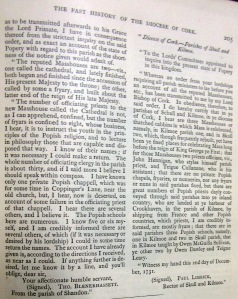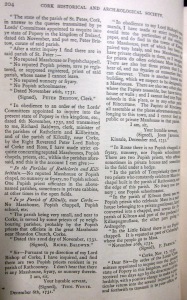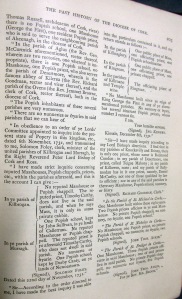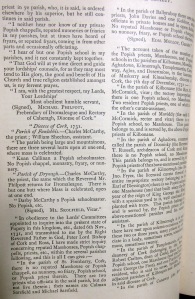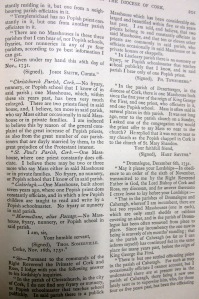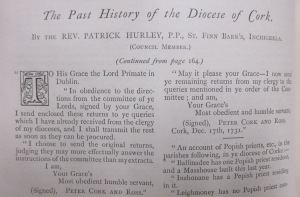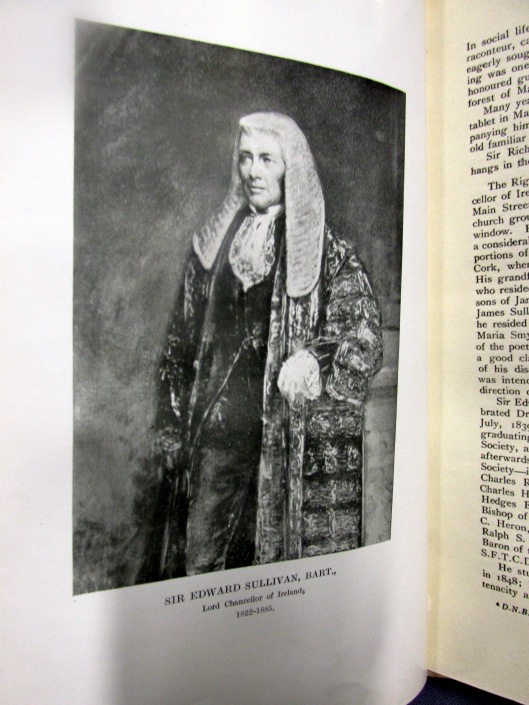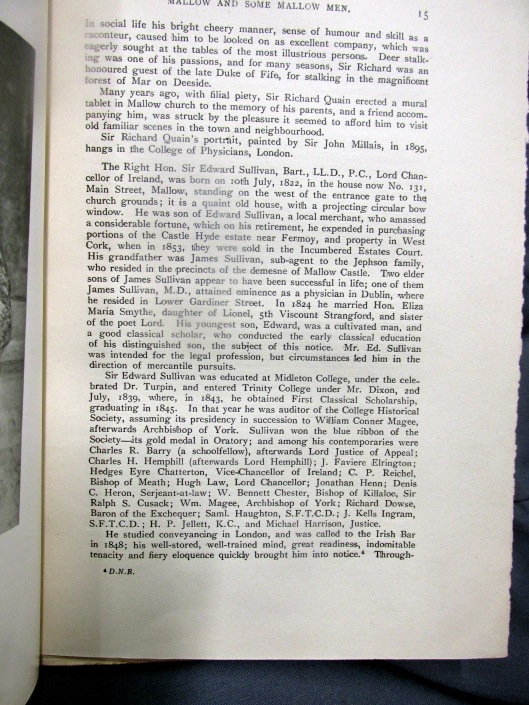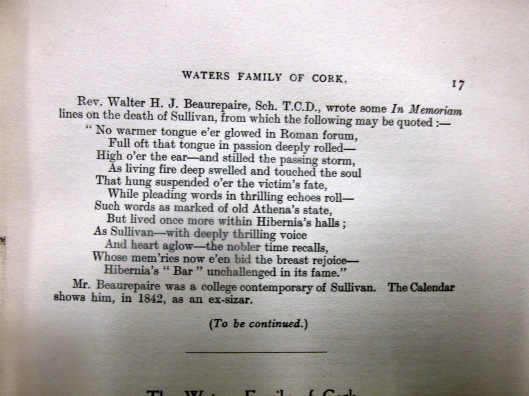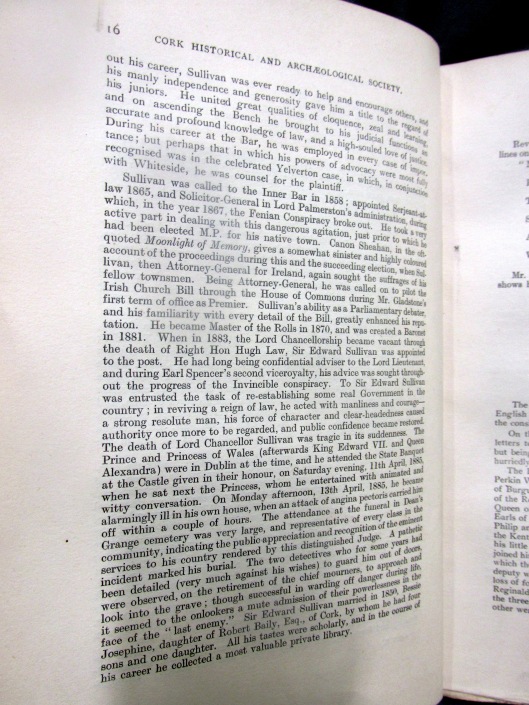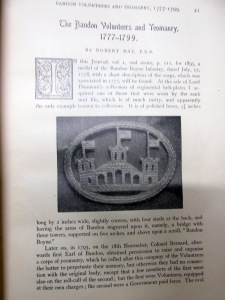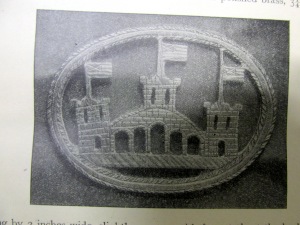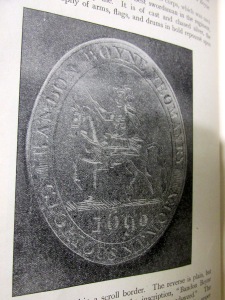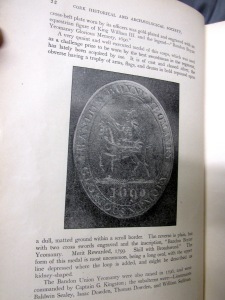From University College Cork online electronic register, CELT.
chapter 15
Bantry, and a visit to Irish Beggars
Complaints of the Fishermen—A castle wrapped in paper—Temperance anecdote—Testimonies for Temperance—Mary Sullivan—Irish Greetings—‘Thanks to the great God’—‘God save you kindly’—The Beggar’s Hut—A Mother’s Love—Tobacco indispensable to Females—‘God speed ye’
Bantry is a pretty little town, and methinks all towns that lie upon the sea are generally pretty. Ruin, dilapidation, sluggishness, poverty, disorder, and filth are less met with on the sea-coast than in the interior of countries. The sea is in its very nature refreshing, inciting, enlivening, and beneficial. The town is situated on a small handsome bay which branches off from the large one. Bantry was at one time celebrated for its fisheries, but the fishermen, like many others in Europe, now complain that the fish is no longer so abundant, either because it has greatly diminished in quantity, or taken another direction. When we every where hear these lamentations over the diminished productiveness of fisheries of every description, from the herring to the whale, it is natural to inquire whence it has arisen, and also whether it is not probable that, eventually, we shall have no fish to eat except such as we can breed and fatten in our ponds. Our fishermen are themselves destroying our fish not less effectually than our sportsmen are destroying our game, the waters being much freer to every one than the land, and the fish being much less protected in the breeding season than the feathered race. Whilst, however, the taking of fish is diminishing, that of sea-sand is on the increase. Formerly, only a few boats were employed in this branch of commerce, but now the number of little barks which fish up the coral sand on the sand banks amounts to some hundreds, so that even a new quay, at which we saw them lying in a long row, has been built for their use alone. The increased exertions for the improvement and extension of Irish agriculture is the cause of the great prosperity of this trade.
Even here there is no scarcity of beggars or of rags, as we found when we arrived at the fish-market, which is a walled-in court, surrounded by fish-stands. Scarcely had my companions and I entered it than we were accosted by twenty or thirty
p.153
beggars, who closed the iron gate behind us, at the same time informing us that they would not permit us to depart until we paid them for so doing. We were about to comply with their demands when some of the fishwomen rushed up, and drove away the beggars, saying that this gate, and the tribute to be paid, rightfully belonged to them only.
The town belongs to the Earl of Bantry, whose son, Lord Bearhaven, takes his title from one of the islands in the bay, called Bear Island. Their lordships were both absent, although they do not belong to the regular class of absentees, but generally reside here on their charming domains. We therefore availed ourselves of this opportunity to walk along the shore, and visit their family seat, which is near the town, and is called Bantry Castle. The housekeeper at first refused to admit us, as his lordship was very particular about his house, and besides, the castle was all papered up. This served to increase my curiosity still more, for I had never yet seen an entire castle wrapped in paper. But having removed the scruples of the housekeeper, and obtained an entrance, we actually found every thing inside, from top to bottom, carefully enveloped in paper—in the large sheets of the Cork Constitution, the most extensively-circulated newspaper in the south of Ireland. The door-handles, nay, the entire doors, the bannisters, all the chairs and tables, the chandeliers, the hangings of the walls, all were thus preserved from the dust or the sun. Even a metal figure of St. Patrick himself, and a multitude of old metal dishes, which were hanging from the wall beside and around him, were intrusted to theconservative care of the Cork Constitution. I could not refrain from inspecting these antique dishes somewhat closely, in spite of the paper, for the housekeeper said they were old Spanish articles. The castle, though all very ancient, yet wanted nothing of modern elegance and comfort; for the English alone understand how to unite comfort with antiquity.
My travelling companion from Killarney to Cork, with whom I passed the evening in Bantry over a glass of whisky punch, was a gentleman from Londonderry, who was taking advantage of this beautiful autumn to make a tour of pleasure through the entire of his native isle. He related to me a very remarkable case of temperance, of which the servant who now attended him was the hero, and who, though a quick and dexterous fellow, had formerly been an incorrigible drunkard. He had often reproved him for this vice, punished him, diminished his wages, even promised to reward him if he would keep himself sober for a certain time; but all this was of no avail. As he was for ever relapsing from a brief
p.154
sobriety into a long drunkenness, and had broken all his promises and vows, his master at last discharged him. One day, however, the man again presented himself, adorned with Father Mathew‘s temperance medal, and entreated his former master to take him once more into his service, adding that as he had become a temperance man, and had taken the pledge, there was no likelihood that he would ever relapse into his former bad habits. The master, who knew the character of his countrymen, granted his request without hesitation, and in full confidence that he would prove an orderly servant for the future: and he was not deceived, for now there was not a more useful, more sober, or more exemplary domestic in the kingdom. I tell this story solely because hundreds and thousands like it are told, and because such a sudden change from black to white is admitted to have been produced throughout all Ireland by Father Mathew. Special anecdotes of this kind throw a remarkable light on the Irish character and the temperance cause. Here the testimony of my Killarney host again recurred to me. He stated, that for the last two or three years, since the temperance movement commenced, he could sleep soundly and at his ease, which before it was impossible to do, as the partiality of his people for drink was then so excessive as to render them perpetually quarrelsome and disorderly. But now every thing was changed, and it was no longer necessary for him to superintend every thing in person. He was now certain that the horses were taken proper care of, and he could intrust his boat with perfect confidence to the men, who used formerly to return home drunk and turbulent. Saturday evening, also, which was once wholly dented to dissipation and noise, when his servants used to spend all their week’s wages, he no longer dreaded. The very same people, to whom he might have vainly offered fifty pounds for a sober Saturday, were now all sober as if by enchantment. Such testimonies as these, of which we cannot hear too many, contribute to throw a cheering light on this great and remarkable phenomenon.
My companion also informed me that he had recently attended the great fair of Donegal, where nearly 10,000 people met together. Formerly, faction-fights, quarrels, and drunkenness were here the order of the day; but on this occasion he did not see a single drunken person, nor one quarrel. It appeared to him like a magical metamorphosis.
As my friend, somewhat fatigued by his journey, retired early to rest, I strolled out, late in the evening, along the strand. Whilst thus occupied, something moved past me; and by the rays of light which beamed from the window of a neighbouring house, I was enabled to perceive the strange attire of flowers which,
p.155
during the day, I had seen on the head of one of the beggarwomen at Bantry, I immediately recognised her as one of those who shut us up in the fish-market, and who had been most zealous in her gesticulations and conduct. In fact, her violence on that occasion afforded strong proof of insanity. She was dressed in a tattered yellow gown, and a large red shawl, completely in rags, which seemed to have been originally intended for a much larger person, since half of it trailed behind her in the dust. She also wore a broad-brimmed man’s hat, encircled by a profuse wreath of artificial flowers, and aided by a long stick, which she bore in her hand, she moved along very quickly. Among the beggars of the fish-market she was the loudest, and always held her stick before us to keep us back, whilst whatever she said was spoken extremely quick, and in broken sentences. I have frequently, in Ireland, met with similar half-crazed and comically-dressed beggars, who sometimes reminded me of certain characters in Walter Scott‘s novels. Mary Sullivan (for she soon confided to me her name) was now proceeding very quietly and orderly along the shore of Bantry Bay. I wished her a good evening, when she thanked me politely. Her business for the day was over; and although she still wore the costume of her part, the play was ended, she had left the stage, and was now returning homewards. As she told me that she lived on the shore of the bay, not far from the town, I offered to accompany her, that I might have an opportunity of seeing the hut of an Irish beggar in the evening. We crossed over some uneven rocky ground, and at last turned, as it seemed to me, entirely out of the beaten path; but Mary Sullivan assured me that there was no other way to her sister’s, with whom she lived, and that if I would give her my hand, she would lead me in safety. These poor people prefer localities somewhat wild, and that the approaches to their dwellings should be somewhat rugged; thereby, as they imagine, securing for themselves greater independence. The labours of the English, in constructing level roads, are therefore not always regarded with that joyful thankfulness which might be expected. Besides, a stray piece of perfectly bare and barren ground may be procured somewhat cheaper than a more fruitful soil; and on a naked piece of rocky ground of this description, washed by the gentle waves of Bantry Bay, stood the hut of the Sullivans, into which we crept.
The Irish are a very religious people, and have all kinds of pretty pious wishes always at hand, with which they salute each other. Thus, if they pass by labourers at work in a field, they say, ‘God bless your work!’ to which the answer is, ‘Save you
p.156
too!’ They have so strong a desire for the blessing of God, that they are fond of adding a wish for it to their expressions on all subjects. In particular you must not neglect to add ‘God bless it’ to any thing in the shape of praise you bestow on a person or thing; for instance, if you praise a child by saying, ‘That is a fine child,’ you must, if you wish to save the mother the severest apprehensions, immediately add, ‘God bless it!’ for praise always seems suspicious to the Irish: praise begets envy, they say. It therefore seems to them that the person praising any thing either wishes to possess it himself, or to deform it by drawing down upon it the envy of the fairies and spirits of the lower world, who take special delight in destroying all that is beautiful on earth. When fault is found, it is not customary to add any thing; and an Irish mother would be less offended, if a person were to say to her, ‘Your child is a squalling dirty brat,’ than if he were to say, looking at the child, ‘What a charming little angel you have there in the cradle,’ unless he were immediately to add, ‘God bless him!’ thus warding off the influence of the evil spirits. As they never forget to ask God’s blessing, they are also equally careful to return thanks. ‘Thanks to the great God!’ is an expression continually in their mouths, and I have no doubt in their hearts too. It is customary even to thank God for a misfortune that has befallen them: thus I once heard an Irishwoman, in a melancholy tone and with tears in her eyes, say to another, ‘I have lost my poor dear little child, thanks be to the great God!’ This reminded me of the Russian ‘slawa bogu,’ which is the customary addition to every story; and a Russian merchant who once told me he had made a very bad speculation, like the Irishwoman concluded with ‘slawa bogu,’.
When one creeps into an Irish hut, the usual salutation is ‘God save you all!’ and the answer is, ‘God save you kindly!’ Those who now thus replied to our salutation were the sister of Mary Sullivan and her half-grown daughter, who were both sitting at a turf fire boiling the potatoes, with her little son and little daughter, who were lying beside the pig, eating a half-boiled potato which they had taken from the pot. Their father was not at home, for he had been some days on the water, taking up sand. There came, however, another voice, I knew not from what corner of the house, nor did I know what it meant; only it seemed no ‘God save you kindly!’ I therefore inquired from whence the moaning proceeded. ‘It is my eldest son, your honour; he is weak in the understanding, thanks be to the great God! He often moans thus the livelong day.’
The hut was lighted partly by the fire, and partly by a lamp
p.157
which was suspended from the centre of a crooked rafter. This lamp was a great sea-shell, in which they were burning fish oil by a rush wick. By its melancholy gleam I perceived one of the most miserable and helpless creatures I ever beheld. It was a young man, about twenty years of age, who lay doubled up and groaning in a kind of box which represented his bed, and which was, in reality, the best bed in the hut. Beneath him was some straw, covered with rags; and under his head was a pillow, the only one I remarked in the hovel. His mother showed me some parts of his miserable body. His fingers were quite deformed—two of them had grown together—and his arms were as lean as those of a skeleton. His whole frame seemed to vibrate with a convulsive twitching. His mother said, that this was constantly the case with him. As we were examining his hands and feeling them, he raised himself a little, and looked at us with a vacant stare.
‘He has been so from his birth, your honour,’ said his mother; ‘and we have been obliged to support him for twenty years, without his being able to do the least thing for us.’ It occurred to me that the poor creature might not therefore be well treated, as it is not uncommon for poor people to neglect those who cannot help to increase their earnings.
‘And yet you love him?’ inquired I of his poor mother.
‘Love him? Indeed I do, your honour! Why shouldn’t I love him? Isn’t he my son, my own flesh and blood, God bless him! Eh, mavourneen, look up!’ said she to her unfortunate son, while she carefully raised him, supported his head on her arm, and stroked his crippled hand: ‘I am the only one, sir,’ she continued, ‘who understands his language properly. He is always longing for me, and it seems I am the only one he loves. ‘Tis I give him his potatoes every morning, and, when I have it, stirabout and milk. You see he has a better bed than any of us. Mavourneen! don’t groan so, my darling!’ She smoothed his pillow and laid down his head, which he had again turned away from us.
This woman’s affection for her son caused many thoughts to arise in my mind. It appeared to me that as not only the mental but in some measure the corporeal development of her child had remained almost stationary from his birth, so, in like manner, his mother loved him now with the same tenderness, intensity, and indulgence as when, twenty years ago, he was a suckling. She still fed him as she did then; she coaxed and caressed the youth of twenty years of age as she did the infant of a month. Nay, for twenty years she would have kept him at her breast, were it not physically impossible. When we think of the circumstances of
p.158
people such as these, who have scarcely enough to appease their own hunger, who expect their children to work and to earn money, who usually repel and even imprecate the useless consumer, such affection as I have described may well be called a phenomenon; and it is possible that this poor beggar-woman has shown greater affection for her idiot son than is possessed by a hundred thousand mothers. It is a shame that we travellers so frequently neglect such phenomena, which are so often to be found beneath lowly roofs, instead of seeking them out and making them known to the world.
Mary Sullivan, the old aunt, had meanwhile hung her flower-wreathed hat on the wall, and also laid aside other parts of her costume. She then took from her pocket some potatoes and a fish, which had probably been made a present to her; the former she placed on that corner of the fire which she seemed to consider as her own, and the fish she suspended over it by a wire. She next took out her pipe and began to smoke. She told me, in answer to my inquiry, that her smoking cost her at least a halfpenny a day, or upwards of fifteen shillings a year, exclusive of the many little fragile clay pipes which she must use in that time. This was no inconsiderable sum for a beggar-woman; and as in Ireland a large piece of bread can be purchased for a halfpenny, it is to be wished that another Father Mathewmay arise, to wean the poor Irishwomen from tobacco, and induce them to expend in bread, for themselves and their children, what they now lay out on this useless weed.
Tenderness and hospitality are qualities generally possessed by the Irish. All classes are likewise much at their ease in their intercourse with strangers; and in this respect the higher ranks resemble the Parisians. In many countries, when a stranger visits the huts of the poor, he must undergo a long and scrutinizing stare before they feel comfortable in his presence. With the Irish it is quite the reverse. Poor and half-naked though they may be, such accommodation as they have is instantly offered to their well-dressed visitor without embarrassment; and though they never forget to address him politely, as ‘your honour,’ they always appear to consider him—what he really is— their equal.
When I took my leave of the Sullivans, more than one ‘God speed ye!’ accompanied me to the door, with the most sincere thanks for the honour I had done them by my visit, and for the sympathy which I had shown for the unfortunate brother and son, The two little ones had in the meantime lighted a couple of dry splinters of wood for torches, and accompanied me over their
p.159
rough, rocky path. When at last I drove them back, and bade them good-bye, I saw them for a long time standing above on the rock, lighting my way with their torches, while with their pretty little voices they continually called out, ‘Take care, your honour, take care! God speed ye!’

